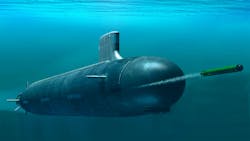Lockheed Martin to provides guidance and control upgrades for Navy Mark 48 submarine-launched torpedo
WASHINGTON – U.S. Navy submarine warfare experts are asking Lockheed Martin Sippican Inc. in Marion, Mass., for upgrades to sonar and guidance systems on the submarine-launched Mark 48 torpedo under terms of a $56.9 million order announced Monday.
Officials of the Naval Sea Systems Command in Washington are asking Sippican to provide new guidance and control sections, as well as sonar upgrade kits, for the Mark 48 Mod 7 torpedo, which is standard armament for the Navy's fleet of Los Angeles-, Virginia-, and Seawolf-class fast attack submarines, as well as Ohio-class ballistic- and cruise-missile submarines.
Sippican will provide Mark 48 Mod 7 guidance and control sections, Common Broadband Advanced Sonar System (CBASS) replacements, spare parts, production support, and related engineering services for torpedo guidance and control sections and CBASS kits.
The Lockheed Martin Corp. Rotary and Mission Systems segment is building the Mark 48 Mod 7 CBASS heavyweight torpedo with advanced common broadband advanced sonar system for shallow waters along coastlines and inside harbors, as well as for the deep-water open ocean.
The CBASS broadband sonar enhancement makes the torpedo more effective against new enemy submarines in the harshest of acoustic environments, Lockheed Martin officials say.
The Mark 48 Mod 7 CBASS torpedo uses modern commercial-off-the-shelf (COTS) technologies and open-architecture computing. It also can be upgraded with regular hardware and software upgrades, Lockheed Martin officials say.
The Mark 48 Mod 7 CBASS kit’s evolutionary design and modular design make the upgrade of older Mark 48 torpedoes to the Mod 7 CBASS capability a relatively straightforward effort without significant redesign and certification, Lockheed Martin officials say.
The CBASS torpedo can use active and passive homing and advanced counter-countermeasures to attack low-Doppler shallow submarines, fast deep diving submarines, and high-performance surface ships. The torpedo uses autonomous fire-and-forget operation or wire-guide capability to enable submarine crews to monitor and update the weapon after launch via the submarine combat system. The torpedo uses Otto Fuel II as its propellant, rather than a battery, to extend its range.
The Mark 48 Mod 7 CBASS can transmit and receive over a wide frequency band and uses broadband signal processing to improve the torpedo’s search, acquisition, and attack effectiveness, Lockheed Martin officials say.
The Mark 48 torpedo is 19 feet long, 21 inches in diameter, and weighs 3,500 pounds. It can dive as deep as 1,200 feet at distances as far as five miles. The torpedo can travel as fast as 28 knots and has a 650-pound high-explosive warhead.
On this order Sippican will do the work in Marion and Braintree, Mass.; and Lemont Furnace, Pa., and should be finished by March 2021. For more information contact Lockheed Martin online at www.lockheedmartin.com, or Naval Sea Systems Command at www.navsea.navy.mil.
